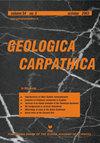Provenance of the Lower Cretaceous clastic rocks from the Gadvan Formation (Zagros Basin, Iran): Evidences from whole-rock geochemistry and petrography
IF 1.5
4区 地球科学
Q4 GEOSCIENCES, MULTIDISCIPLINARY
引用次数: 1
Abstract
The petrography and geochemistry of clastic rocks from the Gadvan Formation in the Abadan Plain (southwest Iran) were analysed to infer their weathering intensity, compositional maturity, provenance, and tectonic setting. The Index of Compositional Variability (0.47–0.71) indicates high compositional and mineralogical maturity. The Chemical Index of Alteration and the Plagioclase Index of Alteration suggest high intensity of chemical weathering in the source area. In addition, a remarkable high content of REE and LREE/HREE and Th/U ratios, as well as high C-value (1.7) suggest high chemical weathering in the source area. Rounded zircon grains, mineral homogeneity, and a lack of feldspar grains could be related to high weathering and the effect of recycling. Elemental ratios (La/Sc, La/Co, Th/Sc, Th/Co, GdN/YbN, Cr/Ni, Co/Th, La/Yb, and La/Th), bivariate diagrams (La/Sc vs. Co/Th, La/Sc vs. Th/Co, Cr/Th vs. Th/Sc, Th/Yb vs. Ta/Yb, and La/ Yb vs. La/Th), and an enrichment of Nb, Zr, Th, La, Cr, Ni contents imply felsic to intermediate parent rocks, which are similar to the massive granitoids of the Arabian Shield. This could be supported by the dominance of zircon grains, as well as inclusions of rutile and tourmaline in quartz grains in the Gadvan sandstones. Moreover, further petrographical evidences, such as undulatory quartz grains, rare biotite and a small orientation of grains is also related to low-grade metamorphism in a felsic source rock. Finally, the Mudrock Maturity Index and tectonic discrimination diagrams reveal a convergence process in a collisional setting, in which the Zagros Mountains originated.Gadvan组(伊朗扎格罗斯盆地)下白垩纪碎屑岩的来源:全岩地球化学和岩石学证据
对阿巴丹平原(伊朗西南部)Gadvan组碎屑岩的岩石学和地球化学进行了分析,以推断其风化强度、成分成熟度、物源和构造背景。成分变异指数(0.47–0.71)表明成分和矿物学成熟度较高。化学蚀变指数和斜长石蚀变指数表明源区化学风化强度较高。此外,REE、LREE/HREE和Th/U比值的显著高含量以及高C值(1.7)表明源区存在高度化学风化。圆形锆石颗粒、矿物均匀性和长石颗粒的缺乏可能与高度风化和回收效果有关。元素比率(La/Sc、La/Co、Th/Sc、Th/Co、GdN/YbN、Cr/Ni、Co/Th、La/Yb和La/Th)、双变量图(La/Sc与Co/Th,La/Sc与Th/Co,Cr/Th与Th/Sc,Th/Yb与Ta/Yb,以及La/Yb/La/Th),以及Nb、Zr、Th、La、Cr、Ni含量的富集意味着长英质至中等母岩,与阿拉伯地盾的块状花岗岩相似。Gadvan砂岩中锆石颗粒占主导地位,石英颗粒中含有金红石和电气石。此外,进一步的岩石学证据,如起伏的石英颗粒、罕见的黑云母和小取向的颗粒,也与长英质烃源岩的低变质作用有关。最后,泥岩成熟度指数和构造判别图揭示了扎格罗斯山脉起源于碰撞环境中的会聚过程。
本文章由计算机程序翻译,如有差异,请以英文原文为准。
求助全文
约1分钟内获得全文
求助全文
来源期刊

Geologica Carpathica
地学-地球科学综合
CiteScore
2.40
自引率
23.10%
发文量
26
审稿时长
>12 weeks
期刊介绍:
GEOLOGICA CARPATHICA covers a wide spectrum of geological disciplines including geodynamics, tectonics and structural geology, volcanology, stratigraphy, geochronology and isotopic geology, karstology, geochemistry, mineralogy, petrology, lithology and sedimentology, paleogeography, paleoecology, paleobiology and paleontology, paleomagnetism, magnetostratigraphy and other branches of applied geophysics, economic and environmental geology, experimental and theoretical geoscientific studies. Geologica Carpathica , with its 60 year old tradition, presents high-quality research papers devoted to all aspects not only of the Alpine-Carpathian-Balkanian geoscience but also with adjacent regions originated from the Mediterranean Tethys and its continental foreland. Geologica Carpathica is an Official Journal of the Carpathian-Balkan Geological Association.
 求助内容:
求助内容: 应助结果提醒方式:
应助结果提醒方式:


